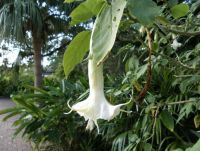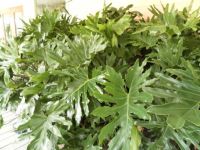
Tropicals for the New Orleans Garden
A Tropical garden features plants that are tropical in nature. They are native to tropical regions and require significant rainfall or a decent irrigation system for watering. Tropical gardens typically need lots of organic matter, fertilizer, mulching, heat and humidity. Tropicals plants are very lush with showy leaves, bright, exotic flowers and fruit.
Tropical gardens are no longer exclusive to tropical areas. Many gardeners in colder climates are adopting the tropical garden design which is possible through careful choice of plants and flowers. Main features include plants with very large leaves, vegetation that builds in height towards the back of the garden, creating a dense garden.
It may not be a good idea to plant an all tropical garden in our area. Generally plant them in the garden after the danger of frost has past in Spring or early Summer. While our winters are mild you run the risk of an occasional hard freeze. When night time temperatures dip below 20 degrees for a number of hours, we run the risk of losing tropical plants. A tropical plant that is not cold-hardy should be brought indoors or covered during the winter and returned to the garden for the summer. Therefore, using tropicals as focal interests or in containers that can be moved indoors is a good idea.
Some tropical plants to consider are…
Hoyas are known as the “Wax Flowers” because of their almost unreal appearance. They do well in relatively warm and humid conditions depending on the specific variety of Hoya. They are commonly used indoors or on a deck or porch. They need indirect light, but the amount or required light depends on the variety. They need small amounts of water and the soil is to be kept slightly dry since a very wet soil can end up killing this kind of plant. They can be grown in hanging baskets or containers that are not too big. They grow better if kept at a minimum temperature of 59 degrees.

Common banana or Musa x paradisiatica is not a tree but is a herbaceous plant which is not that difficult to grow. Bananas can be planted or transplanted in spring or early summer. Add organic matter and some fertilizer at planting. They are large and need lots of room. They require 2 years of grow to produce fruit. Therefore should only be pruned for cold damaged reasons.
Among the many species of birds of paradise is the Strelitzia reginae. As a tropical plant, it grows in warm, humid climates. This exotic, colorful plant, with evergreen leaves resembles a bird’s peak. Works well as a specimen plant. It is an outdoor plant provided the weather is not too cold. Provide thick layer of mulch during freezing weather. Otherwise, it is better to keep it in a pot indoors. Plant in rich organic soil, in sun and on the north side of a structure for protection against winter north winds. Another requirement for this plant is a good drainage.
Ferns are commonly used to give gardens great foliage. Most ferns are easy to take of. They basically cannot be exposed to direct sunlight for long periods of time. Their soil should always be moist. Add organic matter to soil. One way to keep ferns moist is by misting them and/or using mulch around the plants.

Cassava is a tropical, shrubby perennial. This plant goes by the scientific name of Manihot. The variegated form is the one you usually see in landscapes. Once again, garden centers easily sell this plant when they have some available.
Alternanthera used to be called Joseph’s Coat. It is typically placed in the warm-season bedding plant foliage category with plants like coleus. The foliage of most alternantheras is multi-colored. The most spectacular of these is the variety Brazilian Red Hot. This plant may be a perennial in protected landscapes in the New Orleans are, but in most years it is probably best treated as an annual. Some alternanthera do best in sun, and some do best in shade, so be sure to check to see which setting your variety prefers.
Copper plants also continue to be popular. The common copper plant in Louisiana is called “Louisiana Red”. This variety is known for red foliage on a vigorous-growing plant. Other new copper plant varieties include Bronze, Beyond Paradise, Bourbon Street and Swizzle Scissors.
Similar plants to try include durantas, princess flowers (Tibouchina), tricolor hibiscus, purple leaf vitex, ixora, cassias and more. Check out these plants and see which are available locally. All of them are great landscape plants for late summer in Louisiana.
submitted by Karen Blackburn
